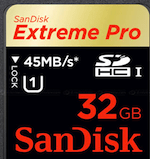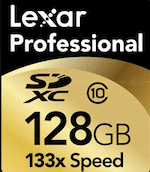Quick Thoughts

In my opinion, the memory card manufacturers are starting to get out of hand when it comes to capacity. I understand 8GB and even 16GB capacity because RAW image files are getting larger each year. But at the same time, camera manufacturers are starting to find ways to make higher megapixel RAW files at a smaller file size. Better yet, converting your RAW files to DNG saves even more space. Is SDXC worth it?
Bigger is better
Higher capacity memory cards are nice for videographers. If you’re video camera now writes to SD memory cards than a 128GB card will record for a very long time. Wonderful!
Bigger is scary

Las Vegas, NV, January 3, 2011 – Lexar Media, a leading global provider of memory products for digital media, today announced new Lexar® Professional Secure Digital Extended Capacity (SDXC) memory cards. The new high-capacity Lexar Professional 133x SDXC cards enable the capture, storage, and transfer of extended lengths of 1080p high-definition (HD) video and continuous, rapid-fire image capture in a single, high-performance solution. The Lexar Professional 133x SDXC card is the first available in a 128GB capacity, and is also offered in a 64GB capacity. Both cards are speed rated at 133x, providing a minimum guaranteed transfer speed of 20MB per second, and feature a Class 10 speed designation. – source: DPReview

Not for me
I use Lexar’s 8GB UDMA Compact Flash (CF) cards. I will not be taking any jumps to higher capacity cards when CF cards get up to 128GB. For me, it’s not worth the risk. My photographs are too important to me. Heck, at 8GB I can still get 300 RAW photos from the Nikon D700. That is more than enough before having to switch cards.
What about you? Comment below and share your input and insights into higher capacity memory cards.
Thanks for reading and happy shooting,
Scott




I’m in the same camp as you. I have 1 16GB & 2 8GB cards and I was taught not to use put all my eggs in one basket for anything (in life in general).
With that said, I’m planning on shooting a 4-day music festival (Sasquatch) over Memorial Day weekend and while I’ll have my laptop in my hotel room, I won’t be able to easily dump off cards, so I’m faced at do I rent a couple of cards (3 8GBs?) or just buy a big card and call it good or what?
Does the body you shoot with have the option for S1/S2/S3 RAW?
-Colby
I shoot with the Nikon D700 so it’s JPG or RAW but the RAW does have a few variations of compression. I always shoot lossless. My suggestion to you is to pick up some extra cards and keep them handy. Why rent when you will wind up using them again one day? Just my opinion :-)
True, renting memory cards versus buying is probably not much different buying compared to renting lenses. I try to be conservative when shooting a show but sometimes I just get trigger happy even though I keep it on Single-Shot for that reason.
I think there is value in both having a couple of bigger cards, and some smaller ones on hand. At a wedding or an event where you can lose a few shots when you’re changing cards, it’s good to have a bigger one.
You’re right on the fact that you don’t want to have all your pics on one card. But most times, a lot of loss of the cards, happen when you decide to change your card, and forget to turn off your camera. Same can be said, that when you have multiple cards, your chance of losing one or more of them becomes higher.
So this is one of those Catch 22’s, and I think having a little of both is good.
128GB’s…. Way too much for pictures, but important for video, that’s a good thing. As long as the limits of recording on Cameras are removed.
Great article to ponder on.
Thanks for your input Didier. I agree that is does have its pros and cons.
I think its important to remember to think in terms of needs versus risks. I’ve migrated from 4 and 8GB cards to 32GB cards because of the type of work I’m pursuing. For example video versus still work will require a lot more storage space and produce fewer files. I’ve used 4 and 8GB cards in the past for the ease in migrating captured work to DVD (~4.4GB capacity) for backup. In 7 years of shooting digital I’ve never had a corrupted CF card and I chalk that up to using name brand CF cards and reformatting in a systematic fashion after each download. It’s good to be aware of risks, but not to be limited by fear of them.
I’ve never had a card corrupt either but I have a lot of customers that it’s happened to. I have performed hundreds of recoveries on memory cards 128mb up to 16gb. I agree that sometimes you just need the space. But for me i’d rather swap cards when I fill a 4 or 8gb card.
On another note. I also have used CF cards for backup. I mix that with Knox for encrypted backups
I’ve never had a CF card corrupt but have had harddrives and SD cards go bad. That said, I do own a 64 GB CF card for times that switching cards is not convenient or I’ll be shooting a lot of video. It was purchased after last year’s Mavericks surf contest where the boat was pitching so wildly that changing cards was a real challenge.
Since I have dual card slots, I have an Eye-Fi card in the SD slot which streams photos off the camera via Mifi so at least there is some redundancy. The card also will delete photos after they have been safely downloaded so I never fill up the memory of the card when I have access to a wifi connection.
That is one heck of a system Rick. Which camera are you using?
Rick,
How do you like the performance of the Eye-Fi card? My colleague, Chris Pedrick tried using an Eye-Fi card but was frustrated with the transfer speed. His setup is Eye-Fi card to 27″ iMac.
My experience with EyeFi cards have been so/so. Slow speeds but it works.
I shoot on a 5dmk2, so don’t want all eggs in one basket, so use 8gb cards. If i had a 1D and could write to 2 cards at same time, i’d just use one big card.